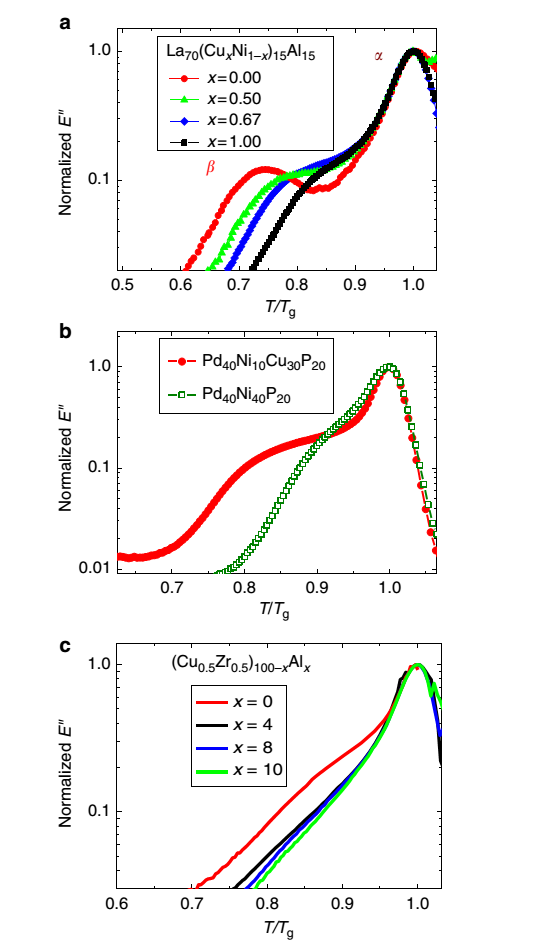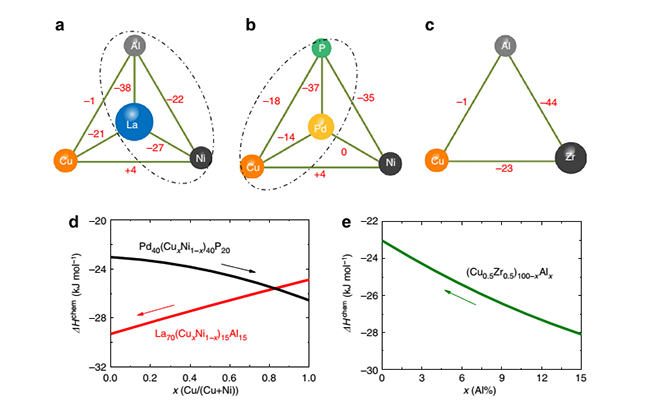Chemical influence on β relaxations in metallic glasses
Date:13-08-2013 Print
Supercooled liquids and glasses are featured with diverse relaxation dynamics. In addition to the primary (α) relaxations that are responsible for viscous flow, a kind of secondary relaxation, called Johari-Goldstein (β) relaxation, often exists at high frequencies or low temperatures.
Prof. WANG Weihua’s group in the Institute of Physics, Chinese Academy of Sciences has been paid special attention to β relaxationfor many years. They use metallic glasses (MGs) as model systems and have demonstrated β relaxations are of significance to the understanding of many key issues in glassy physics and material sciences, ranging from glass transition phenomenon, diffusions, physical aging, to mechanical properties and mechanisms of plastic deformations, as well as the stabilities and crystallizations of glassy materials. [e.g. See a review paper Mater.Today.16, 183 (2013)]
Despite their importance, the behaviors of β relaxation themselves are not well understood. In some supercooled liquids and glasses β relaxations manifest as distinct peaks in dielectric or mechanical loss spectra; while in some other systems β relaxations appear to be absent, instead, an excess contribution to the tail of α relaxation shows up. This so-called excess wing has been observed in many systems without a well resolved peak of β relaxation. A basic question remaining unclear is: Why some glasses exhibit pronounced peaks of β relaxation while others excess wings? This question fundamentally connects to the structural origin of β relaxations, which is also a longstanding unsolved question in glassy physics. Besides, to understand the dominating factors that govern the behaviors of β relaxation are of practical importance. For example, polymers and metallic glasses with pronounced β relaxations at relatively low temperatures usually exhibit good ductility and they are favored for mechanical applications. While for the pharmaceuticals industry, β relaxations are sometimes undesired and should be suppressed as they cause the devitrification and destabilization of glassy medicines which have better solubility and bioavailability than their crystalline counterparts.
Recently, by a systematical scrutiny of the composition dependent β relaxations in several prototypical systems of MGs, Prof. BAI Haiyang and Prof. WANG Weihua in IOP collaboratedwith Dr. YU Haibin and Prof. Konrad Samwer in Göttingen, found a strong chemical effect on the behaviors of β relaxation and they summarized a general rule, that is, the behaviors of β relaxations are correlated to the fluctuations of the chemical interactions among the constituting atoms. Specifically, pronounced β relaxations are always associated with MGs that all the atomic pairs have large similar negative values of enthalpy of mixing and the difference among these values should be small; while positive enthalpy of mixing or a large difference in the enthalpy of mixing suppresses β relaxations. They interpreted these findings in terms of a theoretical idea that string-like excitations are essential for β events. They discussed the implications of this result for the understanding of structural origins of β relaxations in MGs. The obtained insights provide a practical guideline for controlling β relaxations to tailor many properties of MGs and have implications for other type of glasses as well.
This work was published on Nature communications4,2204(2013). It was supported by the National Natural Science Foundation of China.
CONTACT:
Prof. WANG Weihua
Institute of Physics, Chinese Academy of Sciences
Email: whw@iphy.ac.cn
 |
| FIG.1 Behaviors of β relaxations in metallic glasses. (Image by Prof. WANG Weihua et al.) |
 |
| FIG2. Enthalpy of mixing and mean chemical affinity of metallic glasses.Dash-dot ellipses in (a) and (b) indicate compositions with pronounced β relaxations; arrows in (d) and (e) indicate the directions along which β relaxations become more pronounced with composition variations in each systems. (Image by Prof. WANG Weihua et al.) |

